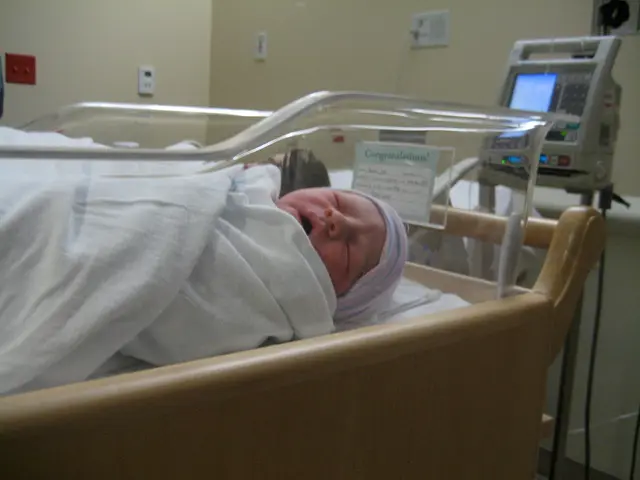Experiencing Back and Leg Discomfort: Examining Causes and Appropriate Medical Consultation
Lower back and leg pain can be caused by various conditions, each with unique characteristics and symptoms. To identify and differentiate between these conditions, including sprains and strains, sciatica, arthritis, fibromyalgia, spinal infection, and ankylosing spondylitis, it is essential to consider the specific symptoms, diagnostic approaches, and key features of each condition.
### Sprains and Strains Sprains and strains occur due to injury or overstretching of muscles, ligaments, or tendons in the lower back. Symptoms include localized pain and stiffness in the lumbar region, worsened by movement, but with no radiating leg pain or neurological signs typically. Diagnosis is based on a history of trauma or overuse and a physical exam showing tenderness and restricted motion without neurological deficits.
### Sciatica Sciatica is characterised by a sharp, burning or stabbing pain that radiates from the lower back or buttock down the leg, usually below the knee. It may be accompanied by numbness, tingling, or muscle weakness in a specific nerve distribution (dermatomal pattern). Pain follows a clear nerve path with neurological signs (reduced reflexes, sensory changes). Sciatica is often caused by compression or irritation of the sciatic nerve roots, often from a herniated disc.
### Arthritis (particularly Osteoarthritis) Arthritis, particularly osteoarthritis, is caused by degeneration of facet joints or other spinal joints. Symptoms include localized lower back pain, stiffness especially in the morning or after inactivity. Pain is usually worse with activity and relieved by rest; no neurological symptoms like radiating leg pain unless there is nerve involvement.
### Fibromyalgia Fibromyalgia is a chronic pain syndrome with widespread musculoskeletal pain and tenderness. Symptoms include diffuse pain including lower back and legs but without nerve root pattern; accompanied by fatigue, sleep disturbances, and cognitive symptoms. Fibromyalgia is diagnosed through exclusion of other causes and symptom-based diagnosis.
### Spinal Infection (e.g., septic arthritis of facet joints, discitis) Spinal infections, such as septic arthritis of facet joints or discitis, are caused by bacterial or other infections in spinal structures. Symptoms include severe back pain, often with fever, localized tenderness, and systemic signs of infection; may cause nerve root irritation if spreading.
### Ankylosing Spondylitis (AS) Ankylosing spondylitis (AS) is a chronic inflammatory arthritis primarily affecting the spine and sacroiliac joints. Symptoms include chronic inflammatory lower back pain starting in young adults, worse in the morning and improving with exercise, associated with stiffness and eventual spinal fusion. AS is diagnosed through clinical criteria, MRI or X-ray showing sacroiliac joint inflammation, and inflammatory markers may be elevated.
A summary table for quick differentiation is provided below:
| Condition | Pain Location | Radiation to Leg | Neurological Signs | Key Features | Diagnostic Clues | |-------------------------|----------------------|------------------------------|------------------------------|-----------------------------------------------|-----------------------------------| | Sprain/Strain | Localized lower back | No | No | History of injury; muscle tenderness | Clinical exam | | Sciatica | Lower back + leg | Yes, below knee, dermatomal | Yes (numbness, weakness) | Sharp radiating pain, positive straight leg raise | Neurological exam + MRI if needed | | Arthritis (Osteoarthritis) | Localized lower back | Usually no | Usually no | Worse with activity; stiffness | X-ray/CT showing joint degeneration| | Fibromyalgia | Widespread (including back) | No | No | Diffuse pain, fatigue, sleep issues | Clinical criteria; exclusion | | Spinal Infection | Localized severe back| Possible (if nerve involved) | Possible (if nerve involved) | Fever, systemic illness, severe pain | MRI + lab tests | | Ankylosing Spondylitis | Lower back and SI joints | Rare | No | Inflammatory pattern of pain (morning stiffness), improved by activity, presence of sacroiliitis on imaging, and HLA-B27 positivity. | MRI/X-ray; HLA-B27 |
In conclusion, a comprehensive clinical evaluation by a healthcare professional is necessary to pinpoint the exact cause and guide appropriate treatment. Immediate medical attention is required for spinal infections, as they can be medical emergencies. Proper posture, exercise, and lifestyle changes can help prevent many back and leg problems.
Multiple entities such as fibromyalgia, arthritis, and ankylosing spondylitis often present with chronic lower back and leg pain, but each condition has unique characteristics and symptoms. Sprains and strains, caused by injury or overstretching, are identified by localized pain, stiffness, and a history of trauma without radiating leg pain or neurological signs. Sciatica, characterized by radiating pain from the lower back or buttock down the leg, may be accompanied by numbness, tingling, or muscle weakness in a specific nerve distribution. Arthritis, particularly osteoarthritis, has localized lower back pain, stiffness, and pain that worsens with activity but relieves with rest, with no neurological symptoms unless there is nerve involvement.
Fibromyalgia is a chronic pain syndrome with widespread musculoskeletal pain, fatigue, sleep disturbances, and cognitive symptoms. Spinal infections, such as septic arthritis of facet joints or discitis, are caused by bacterial or other infections in spinal structures and present with severe back pain, often with fever and systemic signs of infection. Ankylosing spondylitis (AS) is a chronic inflammatory arthritis primarily affecting the spine and sacroiliac joints, with chronic inflammatory lower back pain, morning stiffness, and eventual spinal fusion.
When seeking treatment for these conditions, it's essential to consider other musculoskeletal disorders, predictive factors like age, gender, and personal medical history, as well as other chronic diseases like depression, bipolar, Alzheimer's, and autoimmune disorders that may exacerbate symptoms. Physical therapy and fitness-and-exercise can play a significant role in managing many symptoms, including improving posture, strengthening muscles, and enhancing flexibility.
In some cases, therapies-and-treatments like cbd, neurological-disorders medication, or medical-devices may be recommended to alleviate pain or manage specific symptoms. It's also essential to address mental-health, particularly depression and anxiety, as they often coexist with physical conditions and can impact overall well-being. Workplace-wellness programs, sleep hygiene, and stress management techniques can help mitigate the effects of these conditions on daily life.
Individuals with chronic medical-conditions or chronic-diseases are encouraged to work closely with their healthcare providers to establish appropriate management plans. Some conditions may require ongoing monitoring, such as cardiovascular-health for those with diabetes, or regular screenings for cancer, respiratory-conditions, digestive-health, eye-health, hearing, or skin-conditions. In some cases, treatments like nutrition, skin-care, or medication may be necessary to maintain health and wellness.
For those with neurological-disorders like multiple sclerosis, Alzheimer's, or Parkinson's, close attention should be paid to physical-therapy needs and support services like home-care or assistive-devices to maintain independence and improve quality of life. For those with autoimmune-disorders like rheumatoid arthritis or lupus, a collaborative approach between the patient, healthcare providers, and specialists may be needed to manage symptoms and prevent complications.
Proactively managing health and wellness is crucial in preventing future problems, especially in high-risk populations like aging adults, sports participants, or those with a family history of specific medical-conditions. This may include screenings for cancers at an early stage, addressing sexual-health concerns, managing weight-management, and focusing on preventive self-care like good nutrition, hydration, and regular exercise.
Parenting can also play a significant role in promoting health and wellness, as proper education, boundaries, and role modeling can help children develop healthy habits and build resilience to deal with the challenges of life. Aging, particularly as it relates to mens-health, womens-health, and skin-care, requires ongoing attention and support to address unique health concerns and maximize the potential for a healthy, vibrant, and fulfilling life.
Ultimately, a holistic approach to health and wellness that addresses multiple aspects of physical, mental, and emotional health is essential in ensuring long-term well-being. By working collaboratively with healthcare providers, taking an active role in managing medical-conditions, focusing on nutrition, exercise, and preventive self-care, and prioritizing mental and emotional health, individuals can improve their quality of life and achieve their health goals.




